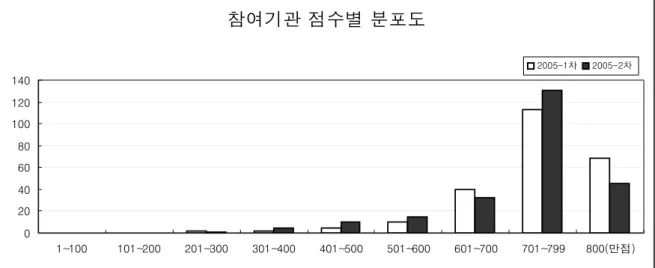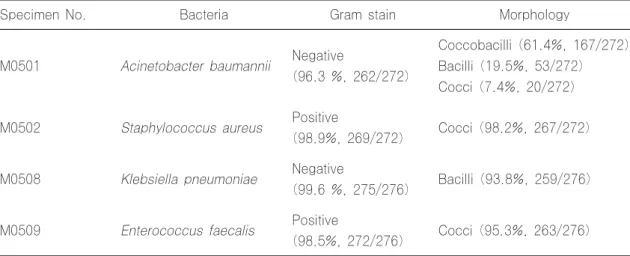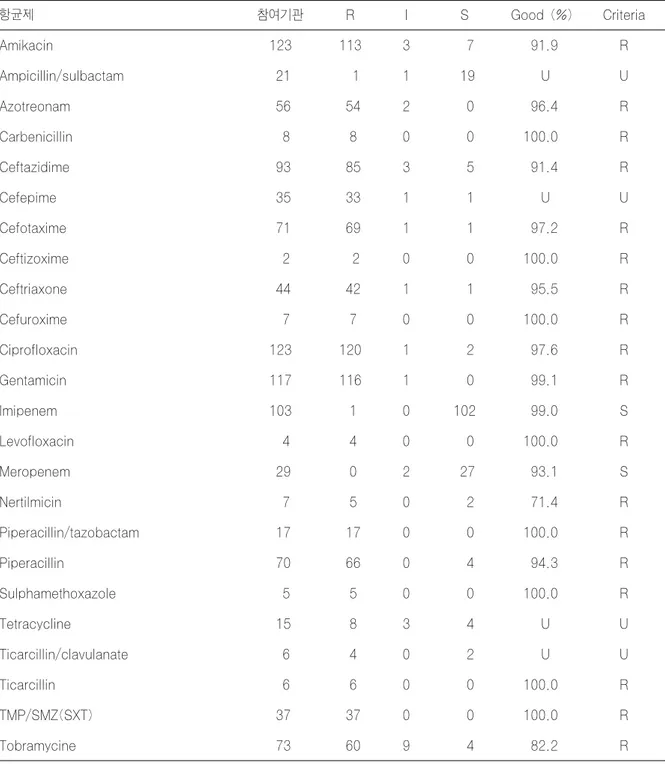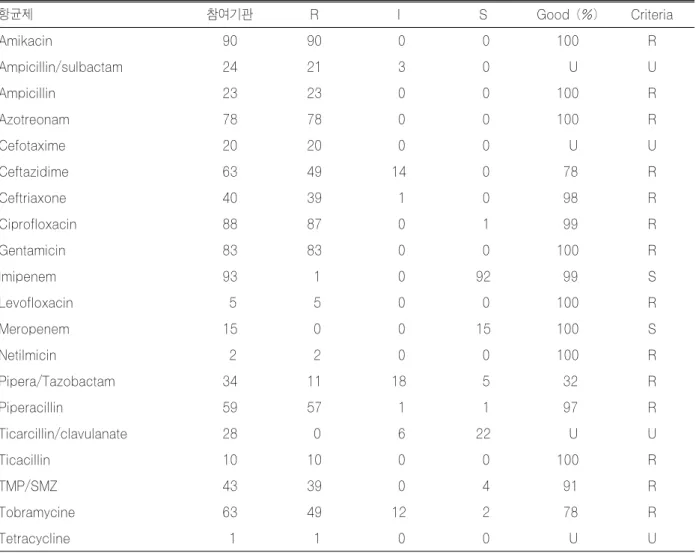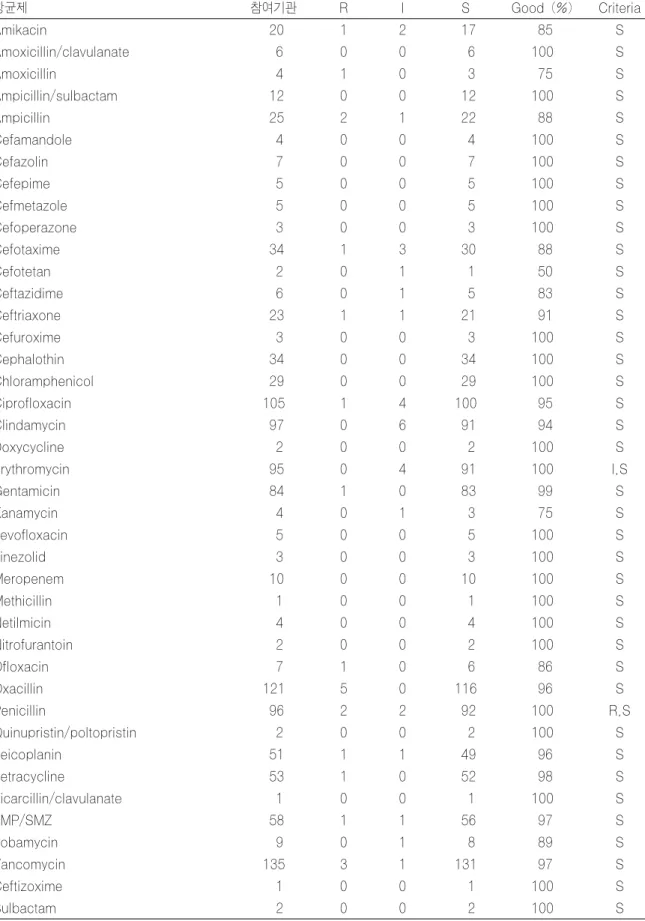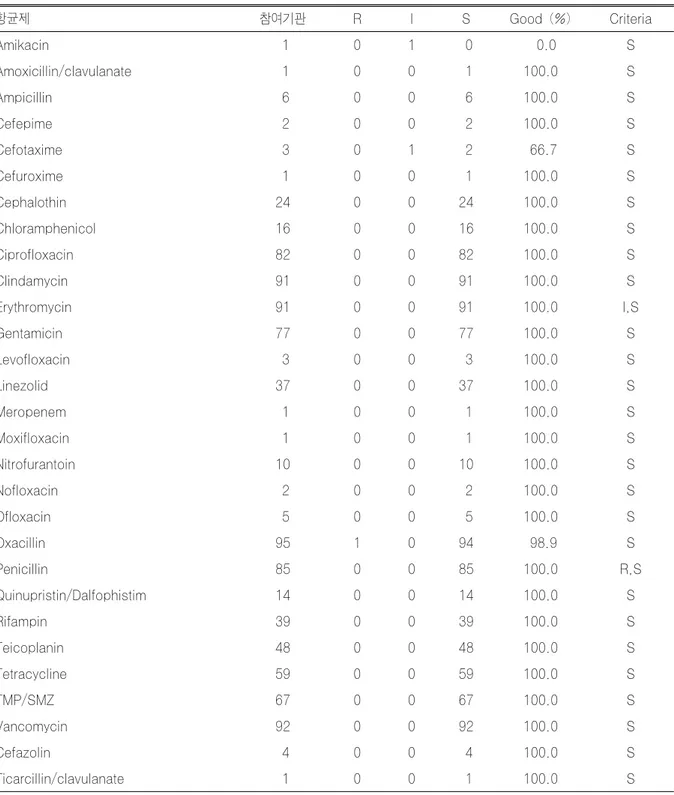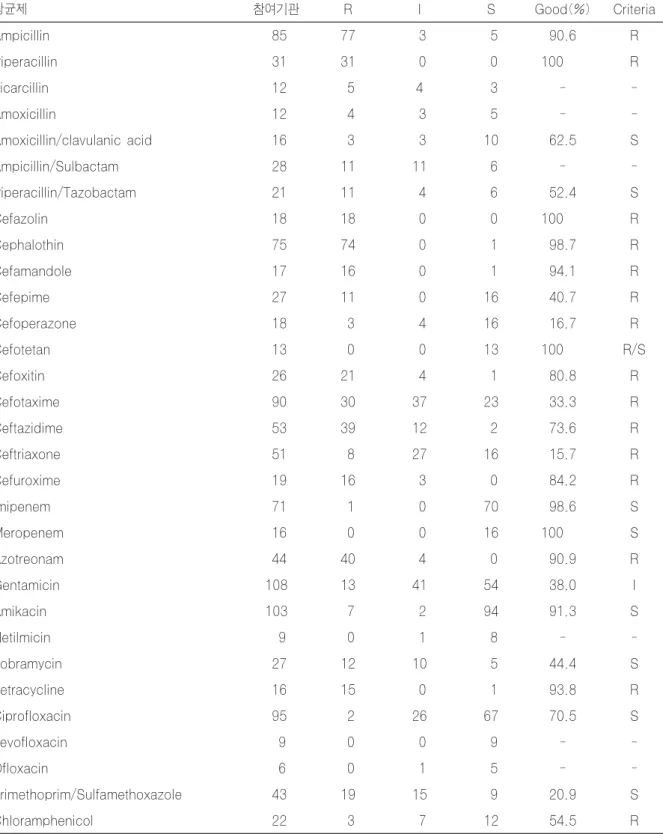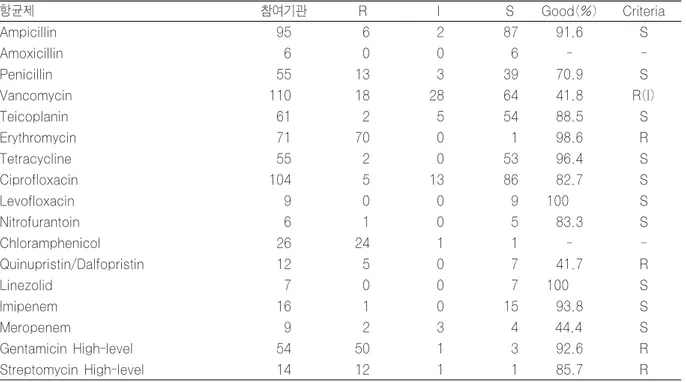임상미생물검사 신빙도조사 결과보고(2005)
이남용(집필대표)․김명숙․김봉철․김민중․김선주․김성일․김의종 김재석․용동은․이장호․이창규․장인호․장철훈․주세익
대한임상검사정도관리협회 임상미생물분과위원회
Annual Report on External Quality Assessment of Clinical Microbiology Laboratory in Korea (2005)
Nam Yong Lee, Myoung Sook Kim, Bong Chul Kim, Min Joong Kim, Sunjoo Kim, Sung Il Kim, Eui Chong Kim, Jae-Seok Kim, Dongeun Yong, Jang Ho Lee, Chang Kyu Lee, In Ho Chang, Chul Hoon Chang, and Se Ik Joo
Clinical Microbiology Subcommittee,
The Korean Association of Quality Assurance for Clinical Laboratory, Seoul, Korea
Two trials of external quality assessment for clinical microbiology laboratory were performed in 2005. A total of 12 specimens were distributed. Six specimens were distributed to 308 laboratories with 272 (88.3%) returns in Trial I and 276 (89.6%) returns in Trial II.
The acceptable percentages of Gram-stain were relatively good. The acceptable percentages of bacterial identification on Acinetobacter baumannii, Staphylococcus aureus, Streptococcus
pyogenes, Aeromonas hydrophila, Enterococcus casseliflavus, Brucella species (Trial I) were 80.1%,
98.3%, 87.6%, 81.3%, 55.5%, 38.1%, respectively. The acceptable percentages of bacterial identification on Klebsiella pneumoniae, Enterococcus faecalis, Brahamella catarrhalis, Burkholderiacepacia, Campylobacter fetus, Rhodoccus equi (Trial II) were 97.5%, 85.9%, 71.0%, 85.9%, 8.3%,
51.0%, respectively. The acceptable percentages for antimicrobial susceptibility tests on Acinetobacter baumannii, Staphylococcus aureus and Klebsiella pneumoniae were relatively high, but those on Klebsiella pneumoniae for ESBL and Enterococcus faecalis for vancomycin- resistance were not high.In conclusion, the acceptable percentages of bacterial stain and identification were relatively good except C. fetus. However, it is necessary that the quality assurance of the individual laboratories should be improved for antimicrobial susceptibility tests, and the selection of the most appropriate antimicrobial agents to test should be also considered.
Key Words:External quality assessment, Clinical microbiology
교신저자:이남용
우) 135-710 서울시 강남구 일원동 50
성균관대학교 의과대학 삼성서울병원 진단검사의학과 전화:02)3410-2706, FAX:02)3410-2719
E-mail:micro.lee@samsung.com
서 론
1976년 대한임상검사정도관리협회가 창립된 후 1977년 에 임상미생물검사 외부 신빙도 조사가 처음으로 시행되었 다. 그 당시 임상미생물검사 외부 신빙도 조사의 참여기관
이 35개였던 것이, 2003년에 240여 기관이었으며, 2004 년에는 293개 기관, 2005년에는 308기관으로 크게 늘어 났다. 그동안 임상미생물분과의 외부 신빙도 조사 사업은 주로 일반세균의 동정과 항균제감수성검사를 대상으로 실시 되고 있었다. 2005년도 임상미생물검사의 신빙도 조사는 총 2회에 걸쳐서 실시하였으며 한 회 마다 여섯 검체를 우 송하였고 모두 일반세균이었다. 그 중 두 균주는 그람염색 과 항균제 감수성 검사를 같이 실시하였고, 나머지 네 균주 는 균동정만 실시하였다.
2005년에도 전년도와 동일한 평가 양식을 사용하였다.
즉, 800점 만점의 종합평가 점수제를 도입하여 각 기관별 평가시 객관성을 부여하도록 하였다. 이는 각 기관에서 정 도관리 결과를 받아보고 좀 더 적극적으로 자신들의 결과를 review하는 동기부여의 목적도 있었다. 또한 이메일 Q &
A를 통하여 각 기관들의 정도관리 결과에 대한 의문점을 해결하도록 하였으며, 세균 동정에서는 평가는 시행하지 않 는 education challenge(연습문제) 항목을 시행하였다.
2005년에도 세균 동정과 더불어 그람염색의 정도관리가 동 시에 시행되었으며 그람염색의 정도관리에만 참여한 기관들 이 있었다.
재료 및 방법 1. 관리물질
관리균주는 구입된 ATCC (American Type Culture Collection) 균주나 삼성서울병원 환자의 검체로부터 분리 된 임상균주 등이었다. 관리균주는 혈액한천배지에 18시간 배양한 후 10% skim milk에 진한 현탁액으로 풀어서 -70℃에서 보관하였다.
각 기관에 발송한 관리물질은 배 등[1]의 방법에 의해서 제조하였다. 균을 혈액한천배지에서 증식한 다음 면봉으로 긁어 모아서 0.75%의 한천(low-melting temperature agarose)이 포함된 brain heart infusion soft agar(3 7℃)에 풀었다. 이 균액을 0.5 mL씩 작은 시험관에 분주 하였다. 우송 시에 소요되는 시간을 감안하여 균의 생존력 을 확인하기 위하여 실제의 관리물질을 제조하기 전에 시험 균주를 미리 일주일간 실온에 보관한 후 혈액한천배지에 계 대배양하여 균이 생존하는 지를 확인하였다.
2. 관리 균주
2005년도 1차와 2차 임상미생물검사 신빙도 조사는 각 각 5월과 11월에 실시하였으며, 대상 세균은 Table 1과 같았다. 일반세균 검체는 혈액한천배지를 일차접종배지로 사용하도록 하였다. 1차와 2차 신빙도 조사에서 평가 예외 항목으로 보낸 동정이 비교적 까다로운 균종으로 1차에서는 Brucella spp.를 2차에서는 Rhodococcus equi를 같이 보냈다. 항생제 감수성검사는 1차에서 Acinetobacter baumannii와 Staphylococcus aureus에 대해서 2차 신 빙도검사에서는 Klebsiella pneumoniae와 Enterococcus faecalis에 대해서 시행하였고 이 때 기대하였던 결과는 Table 2-5와 같다.
3. 검사종목 및 결과분석
검사종목은 각 균주의 그람염색상, 동정검사, 그리고 항 생제감수성검사 이었다. 각 신빙도검사마다 그람염색결과는 두 개의 검체에 대해서 각 검체 당 50점, 동정검사결과는 다섯 개의 검체에 각 100점, 항생제감수성검사는 두개의
검체에 대해서 각 검체 당 100점을 기준으로 하여 총 800 점을 만점으로 하였다. 항생제감수성검사 결과는 NCCLS (CLSI)의 판정기준[2,3]에 따른 해석을 기준으로 하였다.
한편 NCCLS에서 통상적으로 시험하고 보고해야 되는 Group A 항생제가 누락되거나, 반면에 검사대상이 되지 않으며 따라서 판정 기준도 없는 항균제 검사 결과를 보낸 경우, 판정은 맞으나 억제대나 MIC 범위가 벗어나는 경우 는 감점을 하였다.
결 과
결과를 회신한 기관수는 1차에 272(88.3%)기관과 2차 에 276(89.6%)기관이었다. 주로 군부대 기관들과 규모가 작은 기관들이 미생물신빙도 사업에 참여 신청은 하였지만 결과를 보내지 않아 회신율이 저조하였다.
1. 그람염색
그람염색에 대한 결과는 Table 6에 기록하였다.
2. 동정검사 결과
검체번호 M0501은 Acinetobacter baumannii로 총 241기관 중 193기관에서 species level까지 동정하여 80.1%의 정답률을 나타내었다. 검체번호 M0502는 Stap- hylococcus aureus로 4기관만 빼고 모두 species level 까지 동정하여 98.3%의 우수응답률을 나타냈다. 검체번호 M0505는 Enterococcus casseliflavus로 species level 까지 정확히 답한 기관은 전체 241 기관 중에서 55.5%에 불과하였다. 검체번호 M0406은 평가항목에는 포함되지 않 았으며(결과를 보낸 기관은 105기관에 불과) Brucella spp.로 응답한 34기관과 Brucella melitensis로 응답한 6기관을 포함하여 모두 40기관에 불과하였다.
검체번호 M0508은 Klebsiella pneumoniae로 241기 관 중 235기관에서 species level까지 97.5%의 우수응답 률을 나타냈다. 검체번호 M0509는 Enterococcus fae- calis로 241기관 중 207기관에서 species level까지 85.8%의 응답률을 나타냈다. 검체번호 M0512는 Camp- ylobacter fetus로 정확히 답한 기관은 총 241기관 중 9 기관에 불과하였으며, 반면에 Helicobacter pylori로 답한 기관은 31기관이었다. 검체번호 M0513은 평가항목에는 포함되지 않았으며 참여율은 102기관(42.3%)이었다.
Rhodococcus equi로 정확히 응답한 기관은 27 기관이었 으며, Rhodococcus spp.로 응답한 25기관까지 포함하면 전체 정답율은 51%이었다.
2. 항생제 감수성 검사
1차에 보낸 검체번호 M0501은 Acinetobacter baum- annii로 Table 7과 Table 8에 결과가 요약되어있으며, 검
체번호 M0502는 Staphylococcus aureus로 Table 9와 Table 10에 결과가 요약되어있다. 2차로 보낸 검체번호 M0508은 Klebsiella pneumoniae로 Table 11과 Table 12에 결과가 요약되어 있으며, 검체번호 M0509는 Enter- ococcus faecalis로 Table 13과 Table 14에 결과가 요약 되어있다.
고 찰
1차 신빙도사업의 균주인 M0501(Acinetobacter bau- mannii)은 동정과 감수성 검사에서 비교적 우수한 성적을 보였으나, 균명에 대하여는 약간의 혼동이 있었다. Tjern- berg 및 Ursing 등에 의해 분류된 Acinetobacter의 genomic species 중 그룹 1, 2, 3, 13TU 은 그 phe- notype의 유사성 때문에 Peter Gerner-Smidt 등은 Acinetobacter calcoaceticus-A. baumannii complex 로 부를 것을 제안 하였다. 그 이후 혈청학적 및 분자유전 학적 방법을 포함한 보다 상세한 동정 방법 들을 사용한 결 과 이 그룹들이 몇 가지 다른 특징들이 있음이 밝혀져, 그 룹 1은 Acinetobacter calcoaceticus, 그룹 2는 Acine- tobacter baumannii로 명명되게 되었다. 이 Acineto- bacter calcoaceticus-A. baumannii complex는 감별이 쉽지 않아 API 20NE 시스템에서도 DNA-DNA hybri- dization 방법과의 상관성이 그다지 좋지 않은 것으로 보 고되었으며, 일부 automated identification system에서 는 A. calcoaceticus-A. baumannii complex로 결과를 보고한다.
1차에 비평가 균주로서 우송하였던 M0506 (Brucella species) 균주는 최근 급속히 증가하는 Brucellosis 발생 율을 고려하였다. 2002년 8월 전염병 예방법에서 3군 전 염병으로 관리된 이후 2002년 10월 첫 환자가 발생하였고 2003년 16명, 2004년 47명으로 크게 증가하는 추세이다.
2005년 4월까지 이미 37명의 환자가 발생하였으며 최근 소브루셀라병이 유행하고 있어서 이에 대한 주의가 필요하 다. Brucella spp.는 호기성 G(-) coccobacilli이다. 집락 은 pinpoint, convex, smooth, translucent, non-he- molytic, slightly yellow한 특징을 보이며, 천천히 자란 다. 생화학적 검사에서 catalase(+), oxidase (+), rapid urease test(+), PDA test(-)가 특징적이다.
MacConkey 배지에서 자라지 않으나, 혈액한천(BAP)이나 쵸코(CHC) 배지에서 모두 자라며 포도구균에 위성현상을 보이지 않는 특징이 있다. 최근 도입된 Vitek-II는 종수준 에서 이 균종의 동정이 가능하게 되었다. Brucellosis는 혈 액, 림프절, 조직, 관절액 배양에서 위의 특징과 같은 균이 동정될 경우 의심할 수 있다. Brucella는 분리기간이 3-4 일로 다른 병원체에 비해 길고, 이상성 배지는 21일간 배양 하고 자동화 액체배지는 최소 7일 최대 10일간 배양한다.
Brucella가 의심되는 경우 Biosafety Level 3균주에 해당 되므로 모든 작업은 생물학적 안전장치 내에서 시행한다.
따라서 균주 취급시 biologic safety cabinet에서 작업이 이루어져야 하며, 장갑과 마스크를 항상 착용한다. 또한 작 업시 aerosol의 발생을 최소화한다. 평상시도 검체에서 분 리된 균주가 만일 염색소견 등으로 Brucella가 의심되면, 상기한 주의사항을 직원들이 알 수 있도록 검사실 지침 등 에 추가한다. 한편 Brucella 응집소에 대한 혈청학적 검사 가 신속한 검사법이므로 국립보건원으로 보내 항체 검사를 시행한다. 항균제 감수성 검사는 필요 없으며, tetracyclin 이 가장 효과적인 치료제이며 재발 방지를 위해 streo- tomycin등의 병합 요법이 필요하다. 배양 양성인 경우3군 법정 전염병이므로 7일 이내에 보건소에 신고한다.
2차에 우송하였던 Klebsiella pneumoniae subsp.
pneumoniae(ATCC 700603)는 ESBL중에서 SHV-18 을 생성하는 균주이다. NCCLS (CLSI)에 의하면 ESBL 을 생성하는 균주로 확인되면 감수성 결과에 상관없이 penicillins, cephalosporins, aztreonam에 대하여 임상 적으로 내성으로 보고한다(3세대 cephalosporin cefo- taxime, ceftazidime과 4세대 cephalosporin cefepime 포함). 반면에 ESBL 생성 균주는 cephamycin (cefox- itin, cefotetan)이나 carbapenem (imipenem)에 대한 활성은 없는 것으로 알려져 있다. 그러나 cephamycins에 대한 치료 효과는 불분명하다. 이번에 보낸 균주도 ESBL 생성이 확인되었다면 위에 기술된 항균제에 대하여 내성으 로 보고하여야 한다. Ambler Class A ESBL 중에서 TEM과 SHV가 가장 흔하며(TEM- 1, -2, SHV-1의 아 미노산 1-5개 치환), 이 효소의 활성은 cefotaxime 보다 ceftazidime에 더 강하게 작용한다. 국내에서는 SHV-12, -2a, TEM-52, -116 등이 흔하게 보고되었다.
2차에 우송하였던 Enterococcus faecalis (ATCC 51299, vanB genotype)는 VRE 균주이다. NCCLS (CLSI)에 의하면 Enterococcus spp.에 대한 감수성 검사 에서 cephalosporins, aminoglycosides(고농도 검사 제 외), clindamycin, trimethoprim-sulfamethoxazole에 대하여는 in vitro 결과와 상관없이 임상적인 효과가 없으 므로 감수성으로 보고하면 안된다(따라서 검사할 필요도 없 다고 생각됨). 그럼에도 불구하고 많은 기관이 그밖에도 Enterococcus spp.에 적응이 되지 않는 항균제에 대하여 검사를 시행하였다. 이번에 보낸 균주는 표현형이 VanB인 VRE였다(vancomycin 내성, teicoplanin 감수성). 이 균 주는 vancomycin에 낮은 내성을 보이므로 일부의 장비나 디스크법으로 검사 시 쉽지 않았으리라 생각된다. E-test 를 시행하더라도 MIC 판정에 주의하여야 한다. 참고로 이 균주의 vancomycin에 대한 MIC 값은 16-32 ug/mL 이 상이다[5].
Table 15는 1차 신빙도사업 기간에 결핵균 검사에 대한
G ra m s ta in 만 참 여 한 기 관 의 점 수 별 분 포 도
0 5 1 0 1 5 2 0 2 5 3 0
0 점 2 5 점 5 0 점 7 5 점 1 0 0 (만 점 )
2 0 0 5 - 1 차 2 0 0 5 - 2 차
Fig. 1. Gram stain의 신빙도 조사에만 참여한 기관의 점수 분포 기초 조사 자료이다. 전체적으로 256기관이 응답을 하였으
나 미국의 CAP 등 외부정도관리에 참여하는 기관은 매우 적다. 따라서 대한정도관리협회의 미생물분과에서 결핵균 도말과 배양검사의 외부정도관리 사업을 고려중이나 현실적 인 어려움으로 당장 시행되기는 어려울 것 같다.
한편 임상미생물분과에서는 11월에 <바이러스배양검사>
를 주제로 워크샵을 개최하였다. 진행은 Wet 워크샵으로 강의와 더불어 실습을 병행하였으며, 내용은 바이러스 배양 을 위한 검체 처리 및 운송, 세포단층배양법(monolayer cell cultures), 검체접종 및 바이러스 분리 등에 관한 내 용이었다. 참가 인원은 여러 가지 제약으로 소수 인원(30 명)으로 한정하였다. 많은 회원들이 참가를 원하였기에 추 가로 워크샵을 계획중이다.
2005년 시행된 신빙도 사업의 전반적인 정도관리 점수 분포는 Fig. 1, 2를 참조하기 바란다. 결과 작성 시 첨부한 지침을 참조하여, 항균제는 성분명을 적어주고 약자를 사용 하지 말며, 위에서부터 중요한 순으로 적어 달라고 하였으 나 몇몇 기관에서 지침대로 하지 않았다. 검사 항균제의 숫 자를 규정된 항균제 숫자 이상으로 기록하거나, 필요 없는 항균제가 검사되거나, 필수적인 항균제가 누락되는 경우로 인하여 감점되는 경우가 많아, 감수성검사를 실시하는 항생 제의 종류를 균종에 따라 반드시 적절하게 선택하여야 할 것으로 사료된다.
미생물분과위원회
이남용(성균관대학교 삼성서울병원), 김명숙(연세대 세브 란스병원), 김봉철(서울아산병원), 김민중(단국대병원), 김 선주(경상대병원), 김성일(고대안암병원), 김의종(서울대병 원), 김재석(강동성심병원), 용동은(연세대 세브란스병원), 이장호(삼성서울병원), 이창규(고대구로병원), 장인호(원주 기독병원), 장철훈(부산대병원), 주세익(서울대병원)
참 고 문 헌
1. 배직현, 김대근, 김봉철, 김의종, 박정준, 서진태, 이경원, 이규만, 이도현, 조금장, 최태열, 홍석일. 임상미생물검사 신빙도조사 결과보고(1997). 임상병리와 정도관리 1998;20 :17-29.
2. NCCLS. Performance standards for antimicrobial disk sus- ceptibility tests-Sixth edition; Approved standard (M2-A7).
2000
3. NCCLS. Methods for dilution antimicrobial susceptibility tests for bacteria that grow aerobically-Fourth edition;
Approved standard (M7-A5). 2000
4. NCCLS. Perfromance standards for antimicrobial susce- ptibility testing; twelfth informational supplement (M100- S12). 2002
5. Swenson JM, et al. Molecular characterization and multi- laboratory evaluation of Enterococcus faecalis ATCC 51299 for quality control of screening tests for vancomycin and high-level aminoglycoside resistance in enterococci. J Clin Microbiol 1995;33(11):3019-21.
참여기관 점수별 분포도
0 20 40 60 80 100 120 140
1~100 101~200 201~300 301~400 401~500 501~600 601~700 701~799 800(만점) 2005-1차 2005-2차
Fig. 2. 전체 신빙도 조사에 참여한 기관의 점수 분포
Table 1. Microorganims for external quality assessment of clinical microbiology laboratory in 2005
Trial No. Microorganisms Specimen
I
M0501 Acinetobacter baumannii Sputum
M0502 Staphylococcus aureus Blood
M0503 Streptococcus pyogenes Urine
M0504 Aeromonas hydrophila Urine
M0505 Enterococcus casseliflavus Stool
M0506 Brucella species Blood
II
M0508 Klebsiella pneumoniae Blood
M0509 Enterococcus faecalis Urine
M0510 Brahamella catarrhalis Sputum
M0511 Burkholderia cepacia Wound
M0512 Campylobacter fetus Tissue
M0513 Rhodococcus equi Sputum
Table 2. Expected results of antimicrobial susceptability test for Acinetobacter baumannii (M0501)
Selected antibiotics Result
Ceftazidime R
Imipenem or Meropenem S
Amikacin R
Cefotaxime R
Ciprofloxacin R
Ticarcillin R
Piperacillin-tazobactam R
Gentamicin R
Trimethoprim-sulfamethoxazole R
Acinetobacter baumannii (clinical isolate)
Table 3. Expected results of antimicrobial susceptability test for Staphylococcus aureus (M0502)
Selected antibiotics Result
Penicillin R,S
Oxacillin S
Erythromycin S
Clindamycin S
Azithromycin S
Chloramphenicol S
Linezolid S
Gentamicin S
Teicoplanin S
Vancomycin S
Staphylococcus aureus (ATCC 25923)
Table 4. Expected results for antimicrobial susceptability test for Klebsiella pneumoniae (M0508)
Selected antibiotics Result
Ampicillin R
Cefazolin R
Gentamicin I
Amikacin S
Cefoxitin R
Cefotaxime R
Cefepime R
Ciprofloxacin S
Imipenem S
Trimethoprim-sulfamethoxazole S
ESBL (extended-spectrum beta-lactams) positive
Klebsiella pneumoniae (ATCC 700603, beta-lactamase SHV-18)
Table 5. Expected results of antimicrobial susceptability test for Enterococcus faecalis (M0509)
Selected antibiotics Result
Penicillin S
Ampicillin S
Linezolid S
Quinupristin/dalfopristin R
Gentamicin (High level resistance) R
Streptomycin(High level resistance) R
Erythromycin R
Tetracycline S
Teicoplanin R
Vancomycin I,R
VRE, Enterococcus faecalis (ATCC 51299, vanB genotype)
Table 6. Results of Gram stain and bacterial morphology
Specimen No. Bacteria Gram stain Morphology
M0501 Acinetobacter baumannii Negative
(96.3 %, 262/272)
Coccobacilli (61.4%, 167/272) Bacilli (19.5%, 53/272) Cocci (7.4%, 20/272)
M0502 Staphylococcus aureus Positive
(98.9%, 269/272) Cocci (98.2%, 267/272)
M0508 Klebsiella pneumoniae Negative
(99.6 %, 275/276) Bacilli (93.8%, 259/276)
M0509 Enterococcus faecalis Positive
(98.5%, 272/276) Cocci (95.3%, 263/276)
Table 7. Results of antimicrobial susceptibility test for M0501 (Acinetobacter baumannii) with disk method
항균제 참여기관 R I S Good (%) Criteria
Amikacin 123 113 3 7 91.9 R
Ampicillin/sulbactam 21 1 1 19 U U
Azotreonam 56 54 2 0 96.4 R
Carbenicillin 8 8 0 0 100.0 R
Ceftazidime 93 85 3 5 91.4 R
Cefepime 35 33 1 1 U U
Cefotaxime 71 69 1 1 97.2 R
Ceftizoxime 2 2 0 0 100.0 R
Ceftriaxone 44 42 1 1 95.5 R
Cefuroxime 7 7 0 0 100.0 R
Ciprofloxacin 123 120 1 2 97.6 R
Gentamicin 117 116 1 0 99.1 R
Imipenem 103 1 0 102 99.0 S
Levofloxacin 4 4 0 0 100.0 R
Meropenem 29 0 2 27 93.1 S
Nertilmicin 7 5 0 2 71.4 R
Piperacillin/tazobactam 17 17 0 0 100.0 R
Piperacillin 70 66 0 4 94.3 R
Sulphamethoxazole 5 5 0 0 100.0 R
Tetracycline 15 8 3 4 U U
Ticarcillin/clavulanate 6 4 0 2 U U
Ticarcillin 6 6 0 0 100.0 R
TMP/SMZ(SXT) 37 37 0 0 100.0 R
Tobramycine 73 60 9 4 82.2 R
(U) Ungraded (S) Susceptible (I) Intermediate (R) Resistant
Table 8. Results of antimicrobial susceptibility test for M0501 (Acinetobacter baumannii) with MIC method
항균제 참여기관 R I S Good (%) Criteria
Amikacin 90 90 0 0 100 R
Ampicillin/sulbactam 24 21 3 0 U U
Ampicillin 23 23 0 0 100 R
Azotreonam 78 78 0 0 100 R
Cefotaxime 20 20 0 0 U U
Ceftazidime 63 49 14 0 78 R
Ceftriaxone 40 39 1 0 98 R
Ciprofloxacin 88 87 0 1 99 R
Gentamicin 83 83 0 0 100 R
Imipenem 93 1 0 92 99 S
Levofloxacin 5 5 0 0 100 R
Meropenem 15 0 0 15 100 S
Netilmicin 2 2 0 0 100 R
Pipera/Tazobactam 34 11 18 5 32 R
Piperacillin 59 57 1 1 97 R
Ticarcillin/clavulanate 28 0 6 22 U U
Ticacillin 10 10 0 0 100 R
TMP/SMZ 43 39 0 4 91 R
Tobramycine 63 49 12 2 78 R
Tetracycline 1 1 0 0 U U
Table 9. Results of antimicrobial susceptibility test for M0502 (Staphylococcus aureus) with disk method
항균제 참여기관 R I S Good (%) Criteria
Amikacin 20 1 2 17 85 S
Amoxicillin/clavulanate 6 0 0 6 100 S
Amoxicillin 4 1 0 3 75 S
Ampicillin/sulbactam 12 0 0 12 100 S
Ampicillin 25 2 1 22 88 S
Cefamandole 4 0 0 4 100 S
Cefazolin 7 0 0 7 100 S
Cefepime 5 0 0 5 100 S
Cefmetazole 5 0 0 5 100 S
Cefoperazone 3 0 0 3 100 S
Cefotaxime 34 1 3 30 88 S
Cefotetan 2 0 1 1 50 S
Ceftazidime 6 0 1 5 83 S
Ceftriaxone 23 1 1 21 91 S
Cefuroxime 3 0 0 3 100 S
Cephalothin 34 0 0 34 100 S
Chloramphenicol 29 0 0 29 100 S
Ciprofloxacin 105 1 4 100 95 S
Clindamycin 97 0 6 91 94 S
Doxycycline 2 0 0 2 100 S
Erythromycin 95 0 4 91 100 I,S
Gentamicin 84 1 0 83 99 S
Kanamycin 4 0 1 3 75 S
Levofloxacin 5 0 0 5 100 S
Linezolid 3 0 0 3 100 S
Meropenem 10 0 0 10 100 S
Methicillin 1 0 0 1 100 S
Netilmicin 4 0 0 4 100 S
Nitrofurantoin 2 0 0 2 100 S
Ofloxacin 7 1 0 6 86 S
Oxacillin 121 5 0 116 96 S
Penicillin 96 2 2 92 100 R,S
Quinupristin/poltopristin 2 0 0 2 100 S
Teicoplanin 51 1 1 49 96 S
Tetracycline 53 1 0 52 98 S
Ticarcillin/clavulanate 1 0 0 1 100 S
TMP/SMZ 58 1 1 56 97 S
Tobamycin 9 0 1 8 89 S
Vancomycin 135 3 1 131 97 S
Ceftizoxime 1 0 0 1 100 S
Sulbactam 2 0 0 2 100 S
Table 10. Results of antimicrobial susceptibility test for M0502 (Staphylococcus aureus) with MIC method
항균제 참여기관 R I S Good (%) Criteria
Amikacin 1 0 1 0 0.0 S
Amoxicillin/clavulanate 1 0 0 1 100.0 S
Ampicillin 6 0 0 6 100.0 S
Cefepime 2 0 0 2 100.0 S
Cefotaxime 3 0 1 2 66.7 S
Cefuroxime 1 0 0 1 100.0 S
Cephalothin 24 0 0 24 100.0 S
Chloramphenicol 16 0 0 16 100.0 S
Ciprofloxacin 82 0 0 82 100.0 S
Clindamycin 91 0 0 91 100.0 S
Erythromycin 91 0 0 91 100.0 I,S
Gentamicin 77 0 0 77 100.0 S
Levofloxacin 3 0 0 3 100.0 S
Linezolid 37 0 0 37 100.0 S
Meropenem 1 0 0 1 100.0 S
Moxifloxacin 1 0 0 1 100.0 S
Nitrofurantoin 10 0 0 10 100.0 S
Nofloxacin 2 0 0 2 100.0 S
Ofloxacin 5 0 0 5 100.0 S
Oxacillin 95 1 0 94 98.9 S
Penicillin 85 0 0 85 100.0 R,S
Quinupristin/Dalfophistim 14 0 0 14 100.0 S
Rifampin 39 0 0 39 100.0 S
Teicoplanin 48 0 0 48 100.0 S
Tetracycline 59 0 0 59 100.0 S
TMP/SMZ 67 0 0 67 100.0 S
Vancomycin 92 0 0 92 100.0 S
Cefazolin 4 0 0 4 100.0 S
Ticarcillin/clavulanate 1 0 0 1 100.0 S
Table 11. Results of antimicrobial susceptibility test for M0508 (Klebsiella pneumoniae) with disk method
항균제 참여기관 R I S Good(%) Criteria
Ampicillin 85 77 3 5 90.6 R
Piperacillin 31 31 0 0 100 R
Ticarcillin 12 5 4 3 - -
Amoxicillin 12 4 3 5 - -
Amoxicillin/clavulanic acid 16 3 3 10 62.5 S
Ampicillin/Sulbactam 28 11 11 6 - -
Piperacillin/Tazobactam 21 11 4 6 52.4 S
Cefazolin 18 18 0 0 100 R
Cephalothin 75 74 0 1 98.7 R
Cefamandole 17 16 0 1 94.1 R
Cefepime 27 11 0 16 40.7 R
Cefoperazone 18 3 4 16 16.7 R
Cefotetan 13 0 0 13 100 R/S
Cefoxitin 26 21 4 1 80.8 R
Cefotaxime 90 30 37 23 33.3 R
Ceftazidime 53 39 12 2 73.6 R
Ceftriaxone 51 8 27 16 15.7 R
Cefuroxime 19 16 3 0 84.2 R
Imipenem 71 1 0 70 98.6 S
Meropenem 16 0 0 16 100 S
Azotreonam 44 40 4 0 90.9 R
Gentamicin 108 13 41 54 38.0 I
Amikacin 103 7 2 94 91.3 S
Netilmicin 9 0 1 8 - -
Tobramycin 27 12 10 5 44.4 S
Tetracycline 16 15 0 1 93.8 R
Ciprofloxacin 95 2 26 67 70.5 S
Levofloxacin 9 0 0 9 - -
Ofloxacin 6 0 1 5 - -
Trimethoprim/Sulfamethoxazole 43 19 15 9 20.9 S
Chloramphenicol 22 3 7 12 54.5 R
Table 13. Results of antimicrobial susceptibility test for M0509 (Enterococcus faecalis) with disk method
항균제 참여기관 R I S Good(%) Criteria
Ampicillin 95 6 2 87 91.6 S
Amoxicillin 6 0 0 6 - -
Penicillin 55 13 3 39 70.9 S
Vancomycin 110 18 28 64 41.8 R(I)
Teicoplanin 61 2 5 54 88.5 S
Erythromycin 71 70 0 1 98.6 R
Tetracycline 55 2 0 53 96.4 S
Ciprofloxacin 104 5 13 86 82.7 S
Levofloxacin 9 0 0 9 100 S
Nitrofurantoin 6 1 0 5 83.3 S
Chloramphenicol 26 24 1 1 - -
Quinupristin/Dalfopristin 12 5 0 7 41.7 R
Linezolid 7 0 0 7 100 S
Imipenem 16 1 0 15 93.8 S
Meropenem 9 2 3 4 44.4 S
Gentamicin High-level 54 50 1 3 92.6 R
Streptomycin High-level 14 12 1 1 85.7 R
Table 12. Results of antimicrobial susceptibility test for M0508 (Klebsiella pneumoniae) with MIC method
항균제 참여기관 R I S Good(%) Criteria
Ampicillin 93 91 1 1 94.9 R
Piperacillin 18 16 0 2 88.9 R
Amoxicillin/clavulanic acid 24 1 1 22 91.7 S
Ampicillin/Sulbactam 34 16 7 11 - -
Piperacillin/Tazobactam 40 10 13 17 42.5 S
Cefazolin 75 73 1 1 97.3 R
Cefepime 71 45 0 26 63.3 S R
Cefoxitin 26 22 2 2 84.6 R
Cefotaxime 35 30 2 3 85.7 S R
Ceftazidime 56 52 2 2 92.9 R
Ceftriaxone 47 26 17 4 55.3 I R
Cefuroxime 9 7 2 0 77.8 R
Imipenem 100 0 0 100 100 S
Azotreonam 40 38 1 1 95.0 R
Gentamicin 91 25 36 30 40.0 I
Amikacin 104 0 0 104 100 S
Netilmicin 8 0 0 8 - -
Tobramycin 27 1 17 9 33.3 S
Ciprofloxacin 99 0 5 94 95.0 S
Trimethoprim/Sulfamethoxazole 51 21 2 28 54.9 S
Table 15. Survey on mycobacterium tests
기관수 %
결핵검사를 시행하는가?
아니오 239 93.4
예 17 6.6
도말검사 239 100
배양검사 134 56.1
감수성검사 8 3.3
직접검체검사 63 26.4
전담 병리사 수는?
<0.9 20 9.9
1 137 67.5
1.5 16 7.9
2 25 12.3
>2.5 5 2.5
외부 정도관리는?
아니오 212 92.6
예 17 7.4
미국 CAP 9
유전분자 4
기타 4
앞으로 미생물분과에 추가되면 참여는?
염색 221 92.5
배양검사 104 43.5
감수성검사 12 5.0
Table 14. Results of antimicrobial susceptibility test for M0509 (Enterococcus faecalis) with MIC method
항균제 참여기관 R I S Good(%) Criteria
Ampicillin 85 1 0 84 98.9 S
Penicillin 70 2 0 68 97.1 S
Vancomycin 95 69 21 5 94.7 R(I)
Teicoplanin 80 0 0 80 100 S
Erythromycin 34 34 0 0 100 R
Tetracycline 80 0 0 80 100 S
Ciprofloxacin 102 0 2 100 98.0 S
Levofloxacin 19 0 0 19 100 S
Norfloxacin 11 0 0 11 100 S
Nitrofurantoin 22 0 0 22 100 S
Rifampin 24 0 2 22 - -
Chloramphenicol 60 59 0 1 - -
Quinupristin/Dalfopristin 78 67 0 11 85.9 R
Linezolid 55 0 0 55 100 S
Imipenem 31 2 0 29 93.5 S
Gentamicin High-level 45 37 0 8 82.2 R
Streptomycin High-level 32 31 0 1 96.9 R
